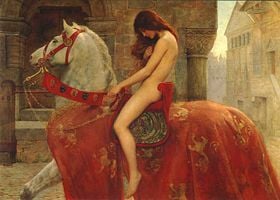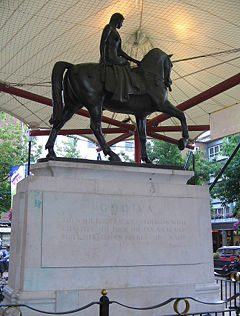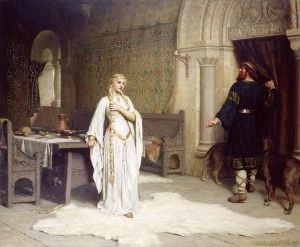Lady Godiva
 From Nwe
From Nwe 
Godiva (or Godgifu) (fl. 1040-1080) was an Anglo-Saxon noblewoman who, according to legend, rode naked through the streets of Coventry in England in order to gain a remission of the oppressive toll imposed by her husband on his tenants. The name "Peeping Tom" for a voyeur comes from later versions of this legend in which a man named Tom watched her ride and was struck blind or dead.
The Historical figure
Lady Godiva was the wife of Leofric (968–1057), Earl of Mercia. Her name occurs in charters and the Domesday survey, though the spelling varies. The Old English name Godgifu or Godgyfu meant "gift of God"; Godiva was the Latinized version. Since the name was a popular one, there are contemporaries of the same name.[1][2]
If she is the same Godgifu who appears in the chronicles of Ely, Liber Eliensis (end of twelfth century), she was a widow when Leofric married her. Both Leofric and Godiva were generous benefactors to religious houses. In 1043 Leofric founded and endowed a Benedictine monastery at Coventry.[3] Writing in the twelfth century, Roger of Wendover credits Godiva as the persuasive force behind this act. In the 1050s, her name is coupled with that of her husband on a grant of land to the monastery of Saint Mary, Worcester and the endowment of the minster at Stow Saint Mary, Lincolnshire.[4][5] She and her husband are commemorated as benefactors of other monasteries at Leominster, Chester, Much Wenlock and Evesham.[6]
The manor of Woolhope in Herefordshire, along with three others, was given to the cathedral at Hereford before the Norman Conquest by the benefactresses Wulviva and Godiva–traditionally held to be Lady Godiva and her sister. The church there has a twentieth century stained glass window depicting them.[7]
Her mark, di Ego Godiva Comitissa diu istud desideravi, appears on a charter purportedly given by Thorold of Bucknall to the Benedictine monastery of Spalding. However, this charter is considered spurious by many historians.[8] Even so it is possible that Thorold, who appears in the Domesday Book as sheriff of Lincolnshire, was her brother.
After Leofric's death in 1057, his widow lived on until sometime beyond the Norman Conquest of 1066. She is mentioned in the Domesday survey as one of the few Anglo-Saxons and the only woman to remain a major landholder shortly after the conquest. By the time of this great survey in 1086, Godiva had died, but her former lands are listed, although now held by others.[9] Thus, Godiva apparently died between 1066 and 1086.[1]
The place where Godiva was buried has been a matter of debate. According to the Evesham Chronicle, she was buried at the Church of the Blessed Trinity at Evesham,[10] which is no longer standing. But, according to the authoritative account in the Oxford Dictionary of National Biography, "There is no reason to doubt that she was buried with her husband at Coventry, despite the assertion of the Evesham chronicle that she lay in Holy Trinity, Evesham."[1]
William Dugdale (1656) states that a window with representations of Leofric and Godiva was placed in Trinity Church, in Coventry,[11] about the time of Richard II.
The Legend

According to the popular story,[13][14] Lady Godiva took pity on the people of Coventry, who were suffering grievously under her husband's oppressive taxation. Lady Godiva appealed again and again to her husband, who obstinately refused to remit the tolls. At last, weary of her entreaties, he said he would grant her request if she would strip naked and ride through the streets of the town. Lady Godiva took him at his word and, after issuing a proclamation that all persons should keep within doors and shut their windows, she rode through the town, clothed only in her long hair. Only one person in the town, a tailor ever afterwards known as Peeping Tom, disobeyed her proclamation in one of the most famous instances of voyeurism.[15] In the story, Tom bores a hole in his shutters so that he might see Godiva pass, and is struck blind.[16] In the end, Godiva's husband keeps his word and abolishes the onerous taxes.
The oldest form of the legend has Godiva passing through Coventry market from one end to the other while the people were assembled, attended only by two knights. This version is given in a handwritten manuscript Flores Historiarum (meaning "Flowers of History") by Benedictine monk Roger of Wendover (d. 1236) from St. Albans. a somewhat gullible collector of anecdotes, who quoted from an earlier writer. The later story, with its episode of "Peeping Tom," appeared first among seventeenth century chroniclers.

At the time, it was customary for penitents to make a public procession in only their shift, a sleeveless white garment similar to a contemporary slip. Thus, some scholars speculate, the Godiva legend may have originated from a trip through town as a penitent, in her shift. Godiva's story may have passed into folk history to be recorded in a romanticized version. Another theory has it that Lady Godiva's "nakedness" may refer to her riding through the streets stripped of her jewelery, the trademark of her upper class rank. However, both these attempts to reconcile known facts with legend are largely speculative; there is no known use of the word "naked" in the era of the earliest accounts to mean anything other than "without any clothing whatsoever."[17]
Moreover, there is no trace of any version of the story in sources contemporary with Godiva, a story that would certainly have been recorded even in its most tame interpretations. Additionally, with the founding of Coventry circa 1043, there was little opportunity for the city to have developed to an extent that would have supported such a noble gesture. Lastly, the only recorded tolls were on horses. Thus, it remains doubtful whether there is any historical basis for the famous ride.
Like the story of Peeping Tom, the claim that Godiva's long hair effectively hid her nakedness from sight is generally believed to have been a later addition (cf. Rapunzel). Certain other thematic elements are familiar in myth and fable: the resistant Lord (cf. Esther and Ahasuerus), the exacted promise, the stringent condition and the test of chastity. Even if Peeping Tom is a late addition, his being struck blind demonstrates the closely knit themes of the violated mystery and the punished intruder (cf. Diana and Actaeon).
Legacy
- The Godiva Procession, a commemoration of the legendary ride instituted on May 31, 1678, as part of Coventry fair, was celebrated at intervals until 1826. From 1848 to 1887, it was revived and continues into the twenty-first century as part of the Godiva Festival.
- The wooden effigy of Peeping Tom which, from 1812 until World War II, looked out on the world from a hotel at the northwest corner of Hertford Street, Coventry, can now be found in Cathedral Lanes Shopping Centre. It represents a man in armor and was probably an image of Saint George. Nearby, in the 1950s rebuilt Broadgate, an animated Peeping Tom watches over Lady Godiva as she makes her hourly ride around the Godiva Clock.[18]
- From the mid-1980s a Coventry resident, Pru Porretta, has adopted a Lady Godiva role to promote community events and good works in the city. In 1999 Coventry councilors considered eliminating Godiva from the city's public identity.[19] As of 2005, Porretta retains the status of Coventry's unofficial ambassador. Each September Poretta marks the occasion of Lady Godiva's birthday by leading a local pageant focusing on world peace and unity known as The Godiva Sisters. In August 2007, the Godiva Sisters was performed in front of 900 delegates from 69 countries attending the World Council for Gifted and Talented Children Biennial Conference held at the University of Warwick.
- Godiva was immortalized anew in the poem Godiva by Alfred Lord Tennyson.
- In Cockney rhyming slang a £5 note (or fiver) is referred to as a Lady Godiva.
Engineering mascot
In many university engineering faculties, military engineering corps and other engineering organizations, Lady Godiva is regarded as a mascot and called the "Patron Saint of Engineers" or "Goddess of Engineering." The origin is unclear, although it probably developed in Britain, where several early engineering schools were founded during the industrial revolution. The practice migrated to North America through Canadian schools, such as the University of Toronto which today holds an annual "Godiva Week" in January consisting of events intended to engender school spirit. By the mid-twentieth century, the practice of engineering organizations associating themselves with Lady Godiva was well established in the United States.
A particular tradition associated with this is that of drinking songs, which make reference to Lady Godiva, particularly Godiva's Hymn[20].
Historically, certain college organizations staged an annual "Godiva Ride" in which a naked female (or a costumed male) rode a horse across campus.[21] This practice may have declined with the advent of modern feminist attitudes.[22]
Opera
The plot of the Pietro Mascagni's opera Isabeau is based on the story of Lady Godiva.
Literature
- In 1939, Dr. Seuss wrote a short illustrated novel entitled The Seven Lady Godivas: The True Facts Concerning History's Barest Family, based on the character.
- Lady Godiva is mentioned in Sylvia Plath's poem "Ariel."
- Lady Godiva also appears in Ezra Pound's poem "Nicotine."
- Lady Godiva also appears in "Godiva," a poem by Sir Alfred Tennyson.
Film
From 1911 onward, several films have been made with the title "Lady Godiva".[23] These include: Lady Godiva Rides Again (1951) starring English actress Diana Dors and Lady Godiva (1955) starring Irish actress Maureen O'Hara.
Notes
All links Retrieved July 7, 2008.
- ↑ 1.0 1.1 1.2 Ann Williams, ‘Godgifu (d. 1067?)’, Oxford Dictionary of National Biography (Oxford University Press, Sept 2004); online edn, Oct 2006 [1] accessed 18 April 2008
- ↑ "Lady Godiva, the book, and Washingborough", from Lincolnshire Past and Present 12 (1993), 9–10. Retrieved July 10, 2008.
- ↑ Anglo-Saxons.net, S 1226.anglosaxons.net.
- ↑ Anglo-Saxons.net, S 1232anglosaxons.net. Retrieved July 10, 2008.
- ↑ Anglo-Saxons.net, S 1478anglosaxons.net. Retrieved July 10, 2008.
- ↑ The Chronicle of John of Worcester, ed. and trans. R.R. Darlington, P. McGurk and J. Bray (Oxford: Clarendon Press, 1995), 582–583
- ↑ Stained glass windows mym's Photostream at flickr.com'. Retrieved July 10, 2008.
- ↑ Anglo-Saxons.net, S 1230anglosaxons.net. Retrieved July 10, 2008.
- ↑ K.S.B.Keats-Rohan, Domesday People: A prosopography of persons occurring in English documents 1066–1166, vol.1: Woodbridge, Suffolk: Domesday (Boydell Press 1999), 218
- ↑ Cecilia Parsons, 1999, 2000, revised by John Collier, 2004."Countess Godiva". Retrieved July 10, 2008.
- ↑ Trinity Church, Coventry.holytrinitycoventry. Retrieved July 10, 2008.
- ↑ Alton Douglas. Coventry: A Century of News. (Coventry Evening Telegraph, 1991. ISBN 0902464361), 62 (photo 2005)
- ↑ Joan Cadogan Lancaster. Godiva of Coventry. With a chapter on the folk tradition of the story, by H.R. Ellis Davidson. (Coventry [Eng.]: Coventry Corp., 1967. OCLC 1664951)
- ↑ K. L. French, ‘The legend of Lady Godiva’, Journal of Medieval History 18 (1992): 3–19
- ↑ Lady Godiva, Historic-UK.com. Retrieved July 10, 2008.
- ↑ "The Historical Godiva", Octavia Randolph. Retrieved July 10, 2008.
- ↑ The Naked Truth, BBC News 2001 Retrieved July 10, 2008.
- ↑ Coventry Now & Then: Hertford Street from Broadgate.historiccoventry. Retrieved July 10, 2008.
- ↑ "Don't Drop Lady Godiva", Coventry & Warwickshire News, 15 November 1999, Retrieved July 10, 2008.
- ↑ [2].grahamnasby. Retrieved July 10, 2008.
- ↑ Charlene Rooke and Rick PilgerFacts, figures, myths, oddities, people, places and traditions that help define the University of Alberta.University of Alberta New Trail Magazine (November 1998). Retrieved July 10, 2008.
- ↑ "Students scrutinize Lady Godiva ride", CBC Archives (February 4, 1990). Retrieved July 10, 2008.
- ↑ 'Lady Godiva'. imdb. Retrieved July 10, 2008.
References
ISBN links support NWE through referral fees
- Darlington, R.R.; P. McGurk and J. Bray. (ed. and trans.) The Chronicle of John of Worcester. Oxford: Clarendon Press, 1995, 582–583. ISBN 9780198207023
- Donoghue, Daniel. Lady Godiva: A Literary History of the Legend. Wiley-Blackwell, 2002. ISBN 1405100478
- Douglas, Alton. Coventry: A Century of News. Coventry Evening Telegraph. February 1991. ISBN 0902464361.
- French, K. L. "The legend of Lady Godiva," Journal of Medieval History 18 (1992): 3–19. ISSN 0304-4181
- Lancaster, Joan Cadogan. Godiva of Coventry, With a chapter on the folk tradition of the story by H.R. Ellis Davidson. Coventry [Eng.]: Coventry Corp., 1967. OCLC 1664951
External links
All links retrieved October 21, 2022.
- "Lady Godiva: The naked truth", BBC News, 24 August, 2001, BBC News – the unearthing of the fourteenth century stained glass window identified with Lady Godiva.
- James Grout: Lady Godiva, part of the Encyclopædia Romana
- How Lady Godiva Got a Tax Break
Credits
New World Encyclopedia writers and editors rewrote and completed the Wikipedia article in accordance with New World Encyclopedia standards. This article abides by terms of the Creative Commons CC-by-sa 3.0 License (CC-by-sa), which may be used and disseminated with proper attribution. Credit is due under the terms of this license that can reference both the New World Encyclopedia contributors and the selfless volunteer contributors of the Wikimedia Foundation. To cite this article click here for a list of acceptable citing formats.The history of earlier contributions by wikipedians is accessible to researchers here:
- Lady_Godiva history
The history of this article since it was imported to New World Encyclopedia:
- History of "Lady Godiva"
Note: Some restrictions may apply to use of individual images which are separately licensed.
↧ Download as ZWI file | Last modified: 02/04/2023 00:51:33 | 5 views
☰ Source: https://www.newworldencyclopedia.org/entry/Lady_Godiva | License: CC BY-SA 3.0
 ZWI signed:
ZWI signed: KSF
KSF